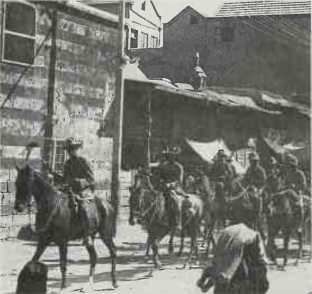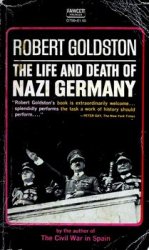Manding the British Army’s 3rd Cavalry Brigade at the Curragh, near Dublin, and 58 of the Brigade’s 71 officers stated that they would resign their commissions if ordered to use force to impose Irish Home Rule on the “loyalist” province of Ulster. Many senior officers, including Sir Henry Wilson, then Director of Military Operations at the War Office, sympathized with the “mutineers”, who were swiftly assured that they would not be ordered to Ulster.
Curtin, John (1885-1945). Australian. Curtin, the leader of his country’s Labour Party, was Australian Prime Minister from October 1941 until his death in July 1945. He firmly believed in the British Commonwealth but, soon after taking office, publicly acknowledged that Australia was now strategically dependent upon the US.
Cushman, Lt Gen Robert E, Jr
(1914—85). US. National security adviser to Vice-President Richard Nixon in 1957; appointed commander of the US 3rd Marine Amphibious Force, Vietnam, June 1967. He was in charge of all Marines and other American forces defending Khe Sanh, Con Thien, the Route 9 outposts. Hue and I Corps during the 1968 Tet offensive. He left Vietnam in 1969 convinced that too much emphasis on static defence had limited the effectiveness of American forces there.
Cuxhaven raid. On December 25 1914, British seaplanes made an unsuccessful attack against the German airship sheds at Cuxhaven. A German airship and seaplanes, in turn, attacked the British seaplane carriers and escorts, making this the first naval action in which aircraft were the principal strike weapons on both sides.
Cyprus (1955-1960). Having been a British Protectorate since 1878, Cyprus became a Crown Colony in 1925. In 1950 it was clear that 95 percent of Greek Cypriots wanted union with Greece (“Enosis”) but the British government refu. sed to consider it. The militant wing of the movement (eoka) gained much popular support. Its leader. Col George Grivas (“Dighenis”) was fanatical and uncompromising whereas Archbishop Makarios 111.
The political leader, was prepared to accept independence without the corollary of Enosis. Grivas and his followers were fully prepared to use terrorist tactics to attain their aim; Makarios deplored murder but condoned sabotage, eoka leant heavily on civilian support and the hard-core terrorists moved freely among the population, on whom they relied for safe houses and supplies. By operating against the British garrison’s lines of communication in rural areas and through acts of selective assassination in towns, Grivas expected the security forces to overreact, which they sometimes did, thereby providing EOKA with much good propaganda. EOKA also terrorized Greek Cypriots hostile to Enosis. Out of 238 civilians killed by eoka between April 1955 and March 1959. 203 were ethnic Greeks.
British troops were deployed in large numbers to sweep and clear rural areas of terrorists. From 1955 they were under command of Field Marshal Sir John Harding, who combined the posts of c-in-c and Governor. Makarios was exiled to the Seychelles. As the campaign hardened, recourse was made to detention centres for eoka suspects, and the security forces tended to use increasingly tough methods. A Turkish paramilitary organization (tmt) was formed; initially for self-defence, it soon became involved in the campaign of murder as eoka turned on the , Turkish population, which tended to support the security forces. Whilst the national governments of Greece and Turkey were reluctant to confront each other over the Cyprus issue, the threat of all-out civil war drove Britain to the negotiating table.
On February 19 1959, an agreement was signed in London creating an independent Republic of Cyprus within the Commonwealth; Britain retained 99 sq miles (256 sq km), to be garrisoned as Sovereign Base Areas (sbas). On March 1, Makarios returned to Cyprus as president elect and the Republic was formally proclaimed on August 16 1960. Four years later, Grivas returned to the island to resume his campaign for Enosis. He had to wait until 1967, following the “colonels’ coup”, for a Greek government which would support him openly. In 1974 he
Instigated a revolt against President Makarios, who was forced to escape to the sba, whilst Turkish troops landed at Kyrenia in the north of the island to establish a de facto partition. This has been the status quo ever since, with a un peacekeeping force to oversee the Greco-Turkish demarcation line. The sbas continue to give Britain a strategic toehold in the Eastern Mediterranean. MH.
Cyrenaica, Rommel’s first offensive into (March 1941). After landing at Tripoli on February 12, Rommel decided to probe the British positions on the Cyrenaica frontier, held by the newly formed Cyrenaica Command (Neame) with the inexperienced and inadequately equipped 2nd Armoured Division and 9th Australian Division.
On April 2, with only half his Afrika Korps ashore, he attacked, taking Mersa Brega. In an extraordinary feat of improvisation and personal drive, he threw Neame’s forces off balance with a rapid advance across the desert via Mechili, capturing Generals Neame, O’Connor and Gambier-Parry on the way, and arriving at Tobruk just too late to take it before the Australians could settle down in its defence. The rest of Neame’s troops fell back to the Egyptian frontier. WGFJ.
Cyrenaica, Rommel’s second offensive into (January 1942). After his defeat during Operation “Crusader”, Rommel’s tank losses were quickly replaced by new shipments that reached Tripoli in mid-January. British forces were again depleted, this time by the need to send troops to the Far East, and were logistically overstretched. Rommel struck back on January 21, forcing Eighth Army (Ritchie) to fall back to the Gazala Line, covering Tobruk. A stalemate ensued while both sides prepared for the decisive encounter that was to come in June 1942. WGFJ.
Czechoslovak Legion. Formed in Russia to fight the Central Powers, the Legion became enmeshed in the Civil War. From 1918 it controlled the Trans-Siberian Railway and frequently clashed with the Bolsheviks before its withdrawal in February 1920.
Dakar, Free French landing at
(September 23-25 1940). Gen de Gaulle, with a largely French force supported by British warships, attempted to oust the Vichy authorities in West Africa. His intentions were leaked by indiscreet talk in London before he sailed. Opposition to him in Dakar was increased by the arrival of French warships from Toulon, which should have been stopped by British forces at Gibraltar. Due to misunderstandings between Whitehall and Adm North at Gibraltar, they were not intercepted. Resistance proved stronger than expected at Dakar, and de Gaulle was forced to withdraw to avoid loss of life through inter-French fighting. Adm North was dismissed on Churchill’s orders. WGFJ.
Dakota see c-47 Dakota.
Dak To, Battle of (1967). The effort to halt communist infiltration into South Vietnam’s central highlands centred upon the US Army Special Forces camp at Dak To, Kontum province, beginning in June 1967. Elements of the US 173rd Airborne Brigade and 4th Infantry Division reinforced the camp’s Special Forces and Montagnard troops to skirmish with the People’s Army (pavn) 24th Regiment. In November a mortar attack on the Dak To airfield hit an ammunition dump, and an American company discovered the pavn 174th Regiment entrenched on Hill 875, 12 miles (19km) west of the camp. From November 19-23 a reinforced battalion assaulted the hill, attaining the summit after extremely heavy napalm and artillery had forced the pavn to withdraw. The outcome temporarily blunted the pavn’s ability to stage major highland operations. WST.
Daladier, Edouard (1884-1970). Fr. As France’s PM and Minister of War before World War II, Daladier led his country’s rearmament programme. He resigned in March 1940 but was later tried by the Vichy regime for his responsibility in France’s unpreparedness.
D’Albiac, Air Marshal Sir John
(1894-1963). Br. Air Commander in Palestine and Transjordan; sent to Greece in November 1940 in command of the raf contingent supporting the Greeks during the Italian invasion in the winter of 1940-41; stayed on as Air Commander during the German invasion in April 1941; then sent to Iraq where he helped crush the Rashid Ali rebellion in May 1941, signing the Convention that restored the Iraqi gvernment on June 1. He continued in command in Iraq until March 1942.
Dalmanutha (Bergandal), Battle
Of (August 21-28 1900), Second Boer War. In a final attempt to preserve the Boers’ last rail supply link with the coast, Botha entrenched 5,000 men on a 30-mile (48km) line along the Delagoa Bay Railway between Belfast and Machadodorp (President Kruger’s headquarters). Advancing from the west, Roberts divided his 20,000-strong force (losses 500), sending Buller with 8,000 men and 38 guns to attack from the south. Botha, expecting the main attack to be made on his flank, had left his centre weak: Buller’s main thrust fell on a sector held by only 74 Zarps (Johannesburg Police). The Boers were forced to evacuate their positions: many, like Kruger, fled to the safety of Portuguese East Africa. RO’N.
Dalton, Dr and Lord (Edward) Hugh (John Neale) (1887-1962). Br. As minister of economic warfare, 1940-42, responsible for soe in its early stages of growth.
Damascus campaign (September-October 1918). By mid-September 1918, Allenby was ready to launch his final offensive against the Turks. His command numbered some 69,000 men (including
12.000 cavalry) and 540 guns.
Opposing him, under Liman von Sanders, were three understrength Turkish armies - Fourth (Jemal Pasha); Seventh (Atatiirk); Eighth (Jerad Pasha): totalling some
40.000 men (including 4,000 cavalry) and 430 guns. Turkish morale, already low, was further shaken by continual raids by the Arab guerrillas under Col T E Lawrence and Prince Feisal. Allenby also had air superiority, enabling him to carry out thorough reconnaissance while denying it to the Turks.
On September 16-18, while Allenby’s aircraft bombed Turkish command centres to disrupt communications and Arab guerrillas struck along the Deraa railway, the major Turkish supply line, Allenby’s XX Corps (Lt (Jen Sir P Chetwode) advanced towards the Jordan valley. This move, together with false intelligence “leaks”, convinced Liman von Sanders that Allenby’s major thrust would be made inland, where he concentrated much of the Turkish strength. Instead, early on September 19, following a brief but intense artillery bombardment.

Gen Chauvel’s cavalry enter Damascus
XXI Corps (Lt Gen Sir E Bulfin) attacked on the coastal front, towards Megiddo. Within hours, an infantry breakthrough created a gap in the coastal Plain of Sharon through which Allenby hurled three cavalry divisions (Desert Mounted Corps; Lt Gen Sir H Chauvel). While 4th Cavalry Division swung east to trap Fourth Army, in concert with XX Corps’ advance inland, 5th Cavalry Division and the Australian Mounted Division drove Seventh and Eighth Armies to the north.
Hotly pursued by the cavalry, and subjected to heavy aerial bombardment and Arab harassment, the Turkish survivors retreated through Damascus (where some
20,000 prisoners were secured by Lawrence’s Arabs and 5th Cavalry Division, October 1), Beirut (fell October 2) and Homs (fell October 16) to Aleppo (fell October 26). On October 30, Turkey capitulated.
Allenby’s superbly planned and executed offensive had resulted in an advance of some 360 miles (580km) in around 40 days, during which the destruction of three Turkish armies and the capture of some 75,000 prisoners cost about 1,200 killed or missing and 4,500 wounded. RO’N.




 World History
World History









